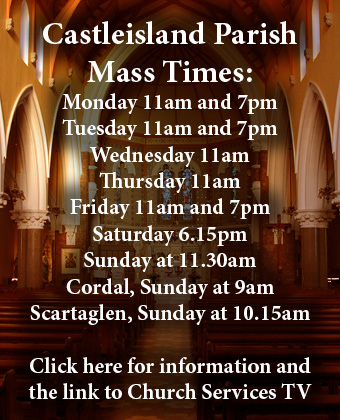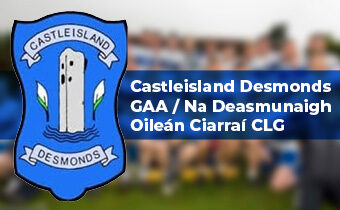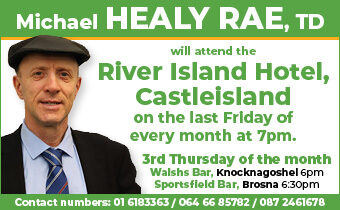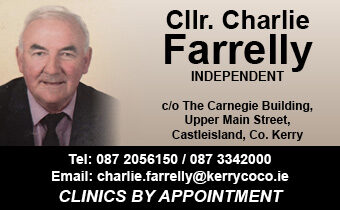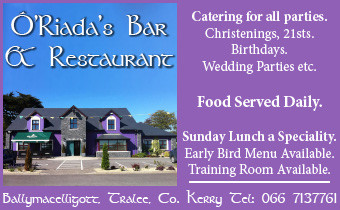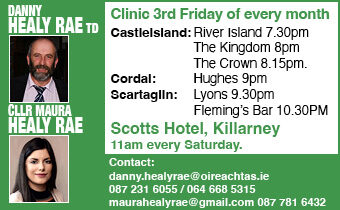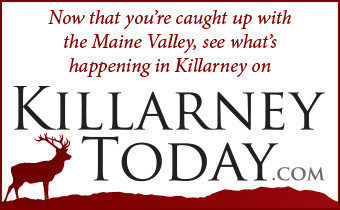

These two photographs came to hand while I was travelling back in time through archives over the past few weeks.
The photographs show two very different faces of Castleisland’s Main Street and its industry with 24 years of ticking time between them.
Two Pieces of Documentary Evidence
Two fairly compelling pieces of documentary evidence show that the original clock was placed on top of The Market House in 1914.
The first, a photograph taken in that year, came to light when Moynihan’s shop and house across the road was being cleared out.
The picture clearly shows the house minus its landmark clock. Then, an artist’s impression from later on that same year shows the building with the clock sitting proudly on top.
The History of the Building
To fully appreciate the history of the building itself it is necessary to look back to the writings of TM Donovan which he included in his book ‘A Popular History of East Kerry’ which was first published in 1931.
However, before he published the book, he serialised much of its eventual contents in weekly columns in The Kerryman in 1929.
He pitched these posts as portraying the events of the town from 60 years before.
He actually started many of these columns with the line: Sixty years ago – as indeed he did with the Market House piece:
“Sixty years ago The Market House now the The Emporium, a finely decorated shop equal to any in the City of Dublin, had three institutions housed within its great walls.
The central portion was the market proper, where farm produce of all kinds was weighed, bought and sold. Three huge gates fronted the Main Street. Many old Castleislanders will remember Mr. John Burke’s brown retriever that guarded those gates at night and sent his loud bark reverberating through the town.
Some used to say that the dog was barking at the headless coach which old Patsy Lawlor averred was often seen passing through the town at the dead of night. The melancholy howl of John Burke’s retriever and that same headless coach prevented many young fellows from staying out too late at night. It was as effective as the Black and Tan curfew of later years.
In those days the markets were held on Tuesdays and, in the height of summer, the inside and the outside as far as The Fountain were occupied by firkins of butter with their golden tops exposed but protected from the dust by green cabbage leaves.
The butter buyers from Tralee and Cork went around with auger-like scoops, smelling and tasting the butter. Some of the big farmers would have as many as three firkins – while smaller farmers would have to combine to make one.
Before the advent of the railway train from Gortatlea, in the early seventies, the butter was dispatched to Tralee by car and to Cork by train via Farranfore.
Earlier than that, it was carried by car and sleds all the way to Cork by road. The sleds and sometimes the horse were sold in the city and the carriers came home in a Bianconi Car.
On the left, as you entered The Market House, was the local dispensary where Dr. Nolan and his assistant dispenser, Mr. Thomas Burke tended to the wants of the sick poor. On the right, where Mr. MJ O’Connor now has his store, was the Court of Petty Sessions where people who indulged too freely in the then ‘two-penny half-ones’ had to appear before the magistrate.
I saw the first telegraph poles being put up in Castleisland in 1871 and the arrival of the first train a few years later.
As a matter of historical interest I might mention that the first passenger to arrive by train was the late Mr. J.K. O’Connor, who so ably represented East Kerry in the County Council for many years. He happened to be in Dublin when our next little engine, that had a first class compartment attached to the tender, was dispatched to Kerry. After the advent of the railway train to Castleisland, the town threw off the swaddling clothes of a village and commenced to grow upwards and outwards rapidly and with great vigour.”










